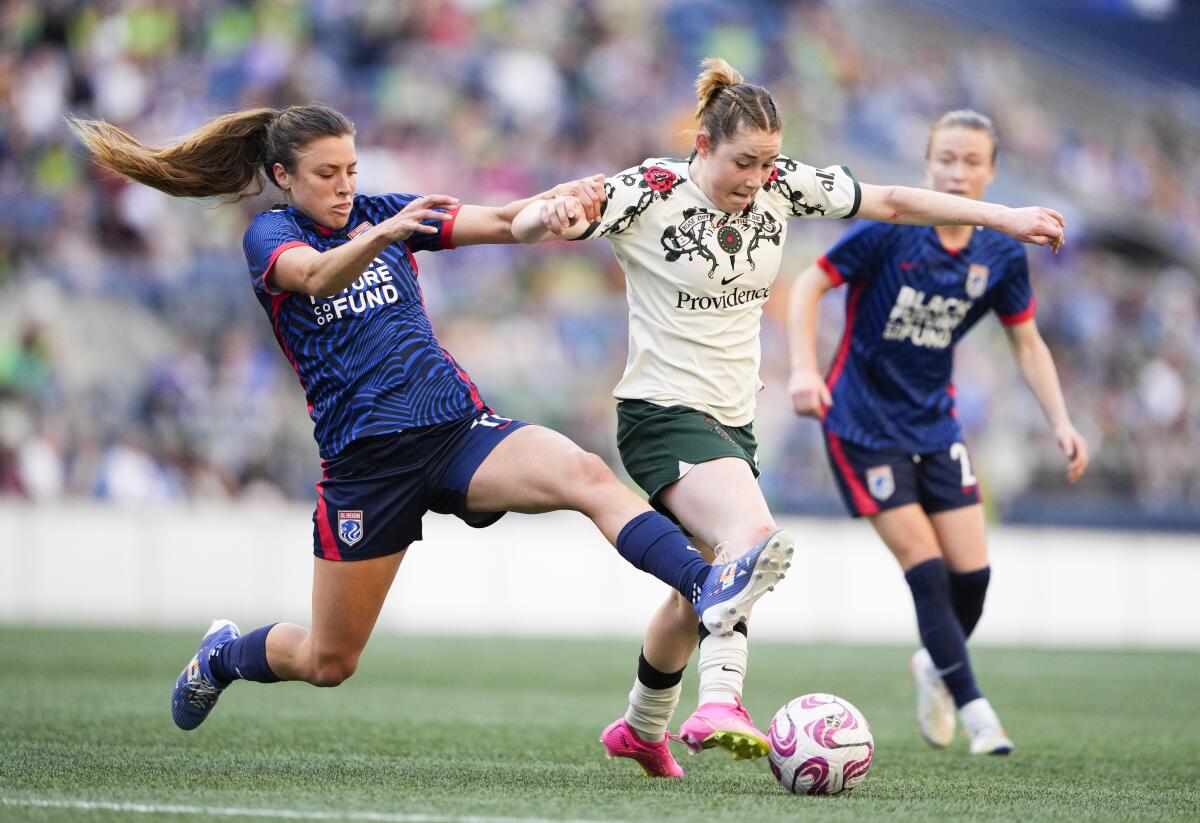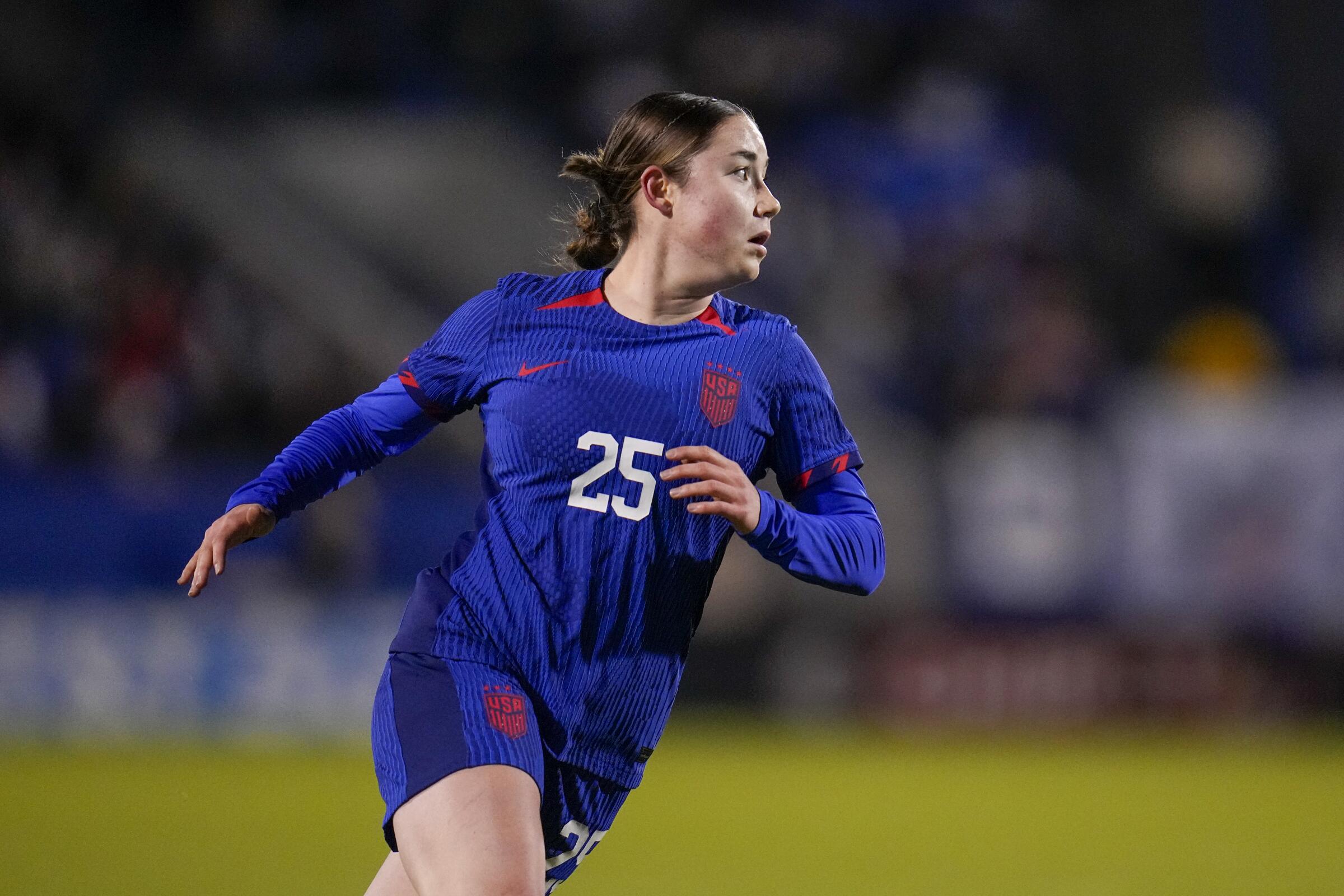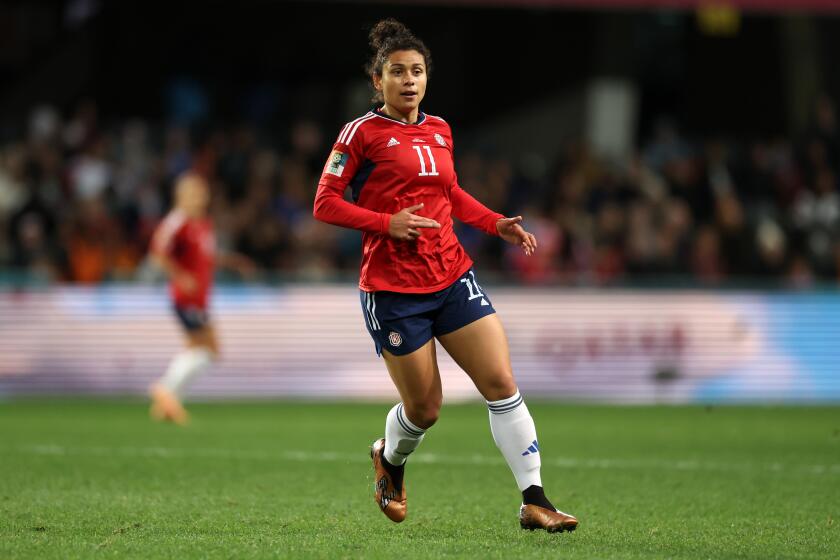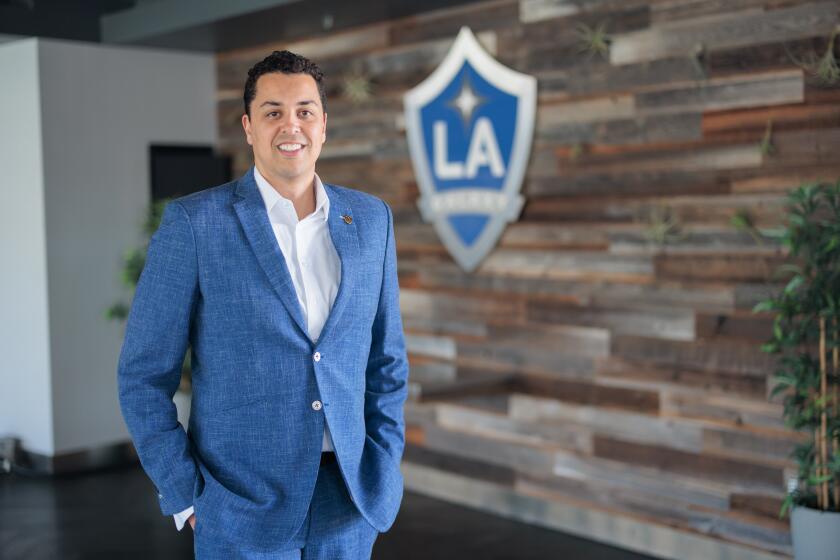Kevin Baxter writes about soccer and hockey for the Los Angeles Times. He has covered seven World Cups, four Olympic Games, six World Series and a Super Bowl and has contributed to three Pulitzer Prize-winning series at The Times and Miami Herald. An essay he wrote in fifth grade was voted best in the class. He has a cool dog.
1
Olivia Moultrie wasnât trying to save the future of womenâs soccer in the U.S. as much as she was trying to jump-start her own career when she sued the NWSL for the right to play.
Nearly three years later, it looks as if she might have accomplished both.
Moultrie, 18, who next month will begin her fourth NWSL season with the Portland Thorns, is the youngest player on a U.S. national team that will open the 12-team CONCACAF W Gold Cup on Tuesday against the Dominican Republic at Dignity Health Sports Park. Mexico will play Argentina in the first game.
It was Moultrieâs courage to successfully challenge the leagueâs age limit in 2021 that opened the door for rising stars such as Chloe Ricketts, Melanie Barcenas and U.S. teammate Jaedyn Shaw, none of whom could have played professionally in the U.S. under the rules Moultrie erased.
âItâs a really special thing to be the person who did that,â Moultrie said last week, days into her third training camp with the national team. âI was just fighting for something that I felt was right. There was an injustice happening. So now seeing what has come of it has been extremely cool for me.â
Age was never more than a number for the precocious Moultrie, who speaks, sounds and acts like someone twice her age.
âIâve always kind of been an old soul,â she said. âIâve always gravitated towards older people, the adults in the room. I prefer to have conversations like that.â
As a child growing up in Santa Clarita, she played like someone twice her age as well. She was introduced to the game at 4 and began intense, soccer-specific training three years later, proving such a prodigy she was soon playing with boysâ teams in the U.S. Development Academy system â the first girl to do so â and on youth national teams with girls who were two and three years older. She made frequent trips to Europe to train with giant clubs such as Bayern Munich, Lyon and Paris Saint-Germain.
At age 11 she became the youngest girl to accept a college scholarship when she committed to North Carolina. At age 13 she became the youngest girl to publicly give up a college scholarship when she signed with the Wasserman Media Group, U.S. soccerâs most powerful agency, then accepted a multiyear endorsement deal with Nike. She also accepted an offer to train with the NWSLâs Portland Thorns, moving with her parents and two younger sisters to Oregon.

(Lindsey Wasson / Associated Press)
So when the league told her sheâd have to wait until her 18th birthday to play for the team, her first question was why?
âIf youâre good enough, youâre old enough,â she said. âThatâs just the precedent that Iâve lived by.
âYou look over at Europe and thereâs no age limit for men or women. Just because I lived in the U.S. and was a female, thatâs literally the only reason I wasnât able to do what I wanted to do.â
In the spring of 2021 she filed an antitrust case alleging that the league, as the âonly acquirer of talent in the market,â violated antitrust laws with its age limit. The court needed less than three weeks to rule in her favor and the league conceded defeat by declining to appeal, clearing the way for the then 15-year-old Moultrie, a midfielder, to make her NWSL debut six weeks later.
Six weeks after that, she scored her first goal against the Houston Dash in the International Champions Cup.
But Moultrie wasnât the only one who benefited. After the 2022 NWSL season, new commissioner Jessica Berman broke with her predecessor and adopted a mechanism for signing players under 18, clearing the way for Ricketts and Barcenas, both 15, to make their league debuts last year.
âThe NWSL is committed to being the best league in the world and developing young talent is central to that mission,â a league spokesperson said last week in a statement. âAnd we also recognize that some of the best players in the world are teenagers. For 2024 we have doubled the number of under-18 players each club can sign, and we will continue to evaluate our roster rules and entry mechanisms, as well as youth development, as we create the most effective pathways for player development.â
The entry process for players under 18 requires teams to provide housing for both the player and a parent/guardian as well as a contract that runs through the season the player turns 18. It also forbids the player from being waived or traded before her 18th birthday and allows for teams to pay for tuition or tutoring without those costs being charged against the league salary cap.
For a national team program that must get younger under interim coach Twila Kilgore, an NWSL full of teenagers will be a welcome change. Angel City will head into this season with a league-high three teenagers, including 16-year-old Korean American Casey Phair, while more than half of NWSLâs 14 teams will have at least one teen.
Angel City has adjusted its roster to meet the needs of a new coach with the hope of making a deeper playoff run a year after its postseason debut.
Thatâs a big change for a league that was the oldest in the world in 2022, with an average age of 27.1 years for the players on the pitch, according to a report from the Swiss-based International Centre for Sports Studies. It will also help rejuvenate a national team that averaged 28.6 years of age at last summerâs World Cup, making it the fourth-oldest team in the tournament.
That trend is trickling down to the lower levels. Last week 13-year-old McKenna Whitham of Mountain View, Calif., the youngest player to sign an NIL agreement with Nike, joined the Santa Clarita Blue Heat, a decorated semipro team on the second level of the U.S. Soccer pyramid and one that provided a starting point for more than two dozen NWSL players.
Yet itâs likely none of that happens without Moultrie having the courage and confidence to take her case to court. Still, she pushes back on the idea that she ignited a revolution because thatâs not what she was aiming to do. For Moultrie, it was simply about clearing a way for her own future; if the path was wide enough for others to follow, so much the better.
âI want to be the best player in the world someday,â said Moultrie, who has appeared in 35 NWSL games (19 starts) over the last two seasons, scoring five times and collecting seven assists. âI obviously want to represent our national team as much as I possibly can. And I knew the best way forward was to become a pro. Seeing there was something in the way, it was just like, âAll right, Iâm just going to have to get past this because Iâm not willing to wait.â Iâm going to do whatever I have to do.
âWe are all in it for evolving womenâs soccer and making it better.â
In this case, that meant making it younger.
â˝ You have read the latest installment of On Soccer with Kevin Baxter. The weekly column takes you behind the scenes and shines a spotlight on unique stories. Listen to Baxter on this weekâs episode of the Corner of the Galaxy podcast.







